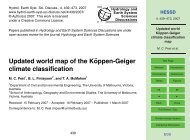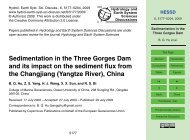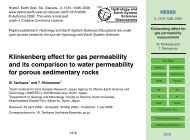In-situ evaluation of internal drainage in layered soils (Tukulu - hessd
In-situ evaluation of internal drainage in layered soils (Tukulu - hessd
In-situ evaluation of internal drainage in layered soils (Tukulu - hessd
Create successful ePaper yourself
Turn your PDF publications into a flip-book with our unique Google optimized e-Paper software.
5<br />
10<br />
15<br />
20<br />
25<br />
5<br />
10<br />
15<br />
20<br />
25<br />
pore space are those <strong>of</strong> diameters rang<strong>in</strong>g from 1000 µm to several mm (Luxmoore,<br />
1981). The variation <strong>in</strong> these classes <strong>of</strong> pores was noticeable with<strong>in</strong> the suction range<br />
<strong>of</strong> 300 to 1000 mm from the soil layers <strong>of</strong> the three soil pr<strong>of</strong>iles. However, the small volume<br />
<strong>of</strong> dra<strong>in</strong>able pores (Dane and Hopmans, 2002; Schaap and van Genuchten, 2005)<br />
found on clay rich horizons was confirmed by the almost level or gentle slope <strong>of</strong> the<br />
θ-h relationship depict<strong>in</strong>g a slow release. Deficiencies <strong>in</strong> clay and structure from the<br />
Swartland pr<strong>of</strong>ile layers, especially the saprolite C horizon resulted to the steep θ-h relationship<br />
that was consistent with the high water release dur<strong>in</strong>g the <strong><strong>in</strong>ternal</strong> <strong>dra<strong>in</strong>age</strong>.<br />
<strong>In</strong>tensity <strong>of</strong> layer<strong>in</strong>g among the three <strong>soils</strong> was also captured by the abrupt changes <strong>in</strong><br />
Ks downwards the pr<strong>of</strong>ile with<strong>in</strong> suction rang<strong>in</strong>g from −10 to −100 mm (Zavattaro and<br />
Grignani, 2001). Notable was the drop from 40 to 9.6 mm h −1 between the neocutanic<br />
B and prismatic C horizons for the <strong>Tukulu</strong>. This discont<strong>in</strong>uities were consistent with<br />
the the behaviour <strong>of</strong> flow and unpredictable nature <strong>of</strong> hydraulic properties <strong>in</strong> <strong>layered</strong><br />
<strong>soils</strong> (Mathews et al., 2004). Another drop <strong>of</strong> 18.1 to 2 mm h −1 between the Sepane<br />
pedocutanic B and prismatic C horizons was recorded alongside the observation that<br />
<strong>in</strong>creased clay content with depth restricted <strong><strong>in</strong>ternal</strong> <strong>dra<strong>in</strong>age</strong> (Romano et al., 1996;<br />
Bohne, 2005; Gopalakrishnan and Manik, 2007; Jones et al., 2009).<br />
Variation <strong>in</strong> K -θ relationship was also able to show the decl<strong>in</strong>e <strong>in</strong> available water for<br />
<strong>dra<strong>in</strong>age</strong> irrespective <strong>of</strong> SWC and depth. Dist<strong>in</strong>guishable were the steep gradients <strong>of</strong><br />
the K -θ relationships from the pedocutanic and prismatic horizons with correspond<strong>in</strong>g<br />
hydraulic gradient fairly above unity. From the orthic and neocutanic horizons this<br />
gradient was almost equal to 1 suggest<strong>in</strong>g that the adoption <strong>of</strong> the unity gradient by<br />
Chimungu (2009) <strong>in</strong> approximat<strong>in</strong>g the K -θ relationship <strong>of</strong> these horizons was reasonable.<br />
However, application <strong>of</strong> the unity gradient is questioned by most researchers<br />
especially on clay <strong>soils</strong> where the K -coefficient could drop by several orders <strong>of</strong> magnitude<br />
with<strong>in</strong> a narrow range <strong>of</strong> SWC (Reichardt, 1993; Bacchi and Reichardt, 1993).<br />
Support<strong>in</strong>g this sentiment was the observation that the K -coefficient from the <strong>Tukulu</strong><br />
and Sepane was less than <strong>dra<strong>in</strong>age</strong> flux at DUL by order <strong>of</strong> one magnitude. The rapid<br />
fall <strong>of</strong> K -coefficient by several orders <strong>of</strong> magnitudes while SWC rema<strong>in</strong>ed with<strong>in</strong> the<br />
9815<br />
near saturation range was also acknowledged by Hensley et al. (2000) who related this<br />
function to the requirements <strong>of</strong> IRWH for deep soil water storage. However, the aff<strong>in</strong>ity<br />
to water shown by <strong>soils</strong> predom<strong>in</strong>ated by micro-pores <strong>of</strong> diameter less than 30 µm<br />
(Luxmoore, 1981), has raised questions on the availability <strong>of</strong> water tightly held aga<strong>in</strong>st<br />
gravity, to roots <strong>of</strong> crop plants (Whitmore and Whalley, 2009). Nevertheless, it can be<br />
deduced from this work that the presence <strong>of</strong> soil layers and their respective permeability<br />
from the three <strong>soils</strong> affected <strong>dra<strong>in</strong>age</strong> differently, and hence soil water storage.<br />
5 Conclusions<br />
The <strong>evaluation</strong> <strong>of</strong> soil layers on <strong><strong>in</strong>ternal</strong> <strong>dra<strong>in</strong>age</strong> from the <strong>Tukulu</strong>, Sepane and Swartland<br />
soil types earmarked for IRWH production technique was the ma<strong>in</strong> objective <strong>of</strong><br />
the study. <strong>In</strong>tegrat<strong>in</strong>g <strong>in</strong>-<strong>situ</strong> and laboratory desorption procedures provided the opportunity<br />
to reflect on the pedological presence <strong>of</strong> soil layers and also to relate their<br />
morphological features to the hydraulic characteristics that governed the <strong>dra<strong>in</strong>age</strong> process.<br />
Critical conclusions were drawn from the total and rate <strong>of</strong> <strong>dra<strong>in</strong>age</strong> expressed by the<br />
three soil pr<strong>of</strong>iles. By virtue <strong>of</strong> their f<strong>in</strong>e size (less than 0.002 mm) the clay fraction<br />
determ<strong>in</strong>ed the extent <strong>of</strong> layer<strong>in</strong>g, both <strong>in</strong> texture and structure. Consequently, the<br />
clay content <strong>in</strong>fluenced the soil water release and permeability dur<strong>in</strong>g <strong>dra<strong>in</strong>age</strong>. Soil<br />
horizons with clay content rang<strong>in</strong>g from 26 to 48 % contributed less than 5 mm to total<br />
<strong>dra<strong>in</strong>age</strong> irrespective <strong>of</strong> textural and structural class. This suggests that from an annual<br />
ra<strong>in</strong>fall <strong>of</strong> 550 mm <strong>dra<strong>in</strong>age</strong> losses from each pr<strong>of</strong>ile layer with clay content fall<strong>in</strong>g <strong>in</strong><br />
this category should be around 1 % <strong>of</strong> the total ra<strong>in</strong>fall. Consider<strong>in</strong>g <strong>dra<strong>in</strong>age</strong> flux <strong>of</strong><br />
0.001 mm h −1 to correspond to DUL produced realistic estimates that were consistent<br />
with the slope <strong>of</strong> θ-T relationships and could be used to estimate DUL from other<br />
<strong>layered</strong> <strong>soils</strong> especially those earmarked for IRWH.<br />
Proven by this work was the variation <strong>of</strong> <strong>dra<strong>in</strong>age</strong> with the degree <strong>of</strong> soil layer<strong>in</strong>g. The<br />
coefficient <strong>of</strong> both saturation and de-saturation allowed reflection on the extent at which<br />
9816<br />
Discussion Paper | Discussion Paper | Discussion Paper | Discussion Paper |<br />
Discussion Paper | Discussion Paper | Discussion Paper | Discussion Paper |







